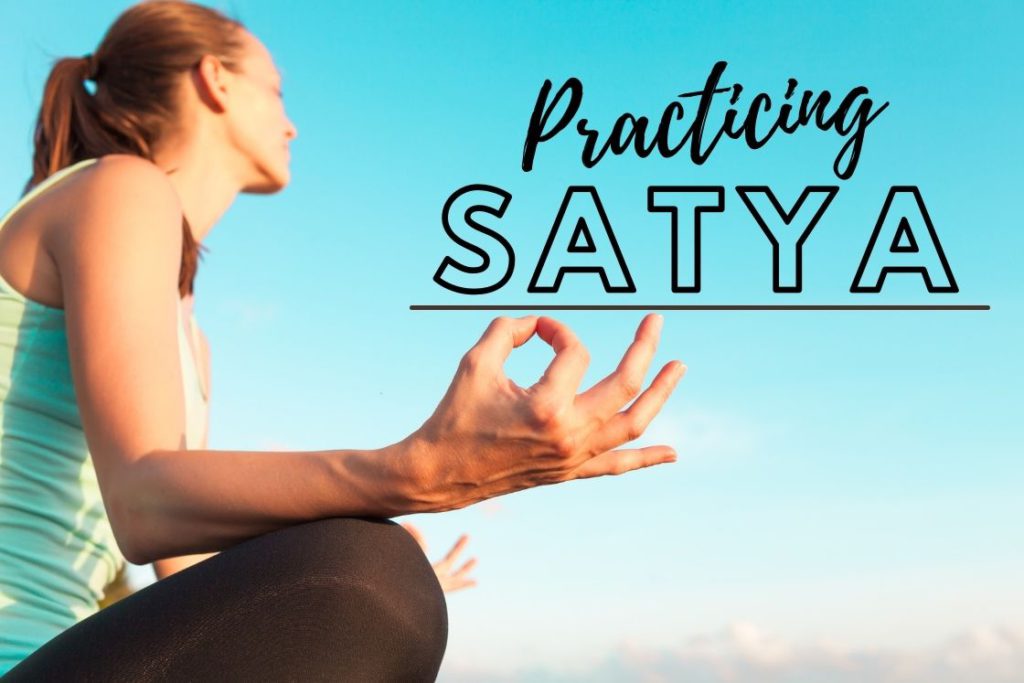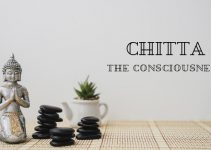
We all know that honesty is the best policy. But how often do we really follow through on those crucial moments when it is needed the most. Hardly ever would we have thought!
Following Satya or truthfulness all along is very difficult. No man can be truly truthful unless there is a conscious observation of his own actions, thoughts and words. That’s not how Patanjali laid the foundation of yoga on Satya or more preciously on the 5 Yamas.
What is Satya?
Satya is the second of 5 Yamas after Ahimsa (Non-violence) described in Patanjali’s Yoga Sutra. According to Patanjali, Satya is restraint from falsehood in our physical self (our actions and body), what we say, (our words, speech, writing) and our mind, (our feelings and thoughts).
Indeed, the journey of practising Satya begins with ourselves – living as our most authentic self and doing things daily that bring inner happiness and joy is the practice of Satya itself. We usually limit the essence of Satya to “what we say”, but it’s what we live. Satya is expressing things as they are and not as one wants them to be. It is the “truth” about something and not a “belief” around it. The Truth is absolute and everything else is just relative to it.
How to Practice Satya in Daily Life?

Practising Satya means accepting your true thoughts, potentials and limitations. Being aware of yourself is the way of living a peaceful life. Be honest with yourself, what you do – how do you feel – how you want to express it. Then be honest with others, don’t let the thought of being judged by others intervene your words.
Satya in daily life helps us to know ourselves as we are. It guides us to experience all ranges of varying emotions in our minds and be aware of ourselves.
Here are some easy ways to imbibe the Satya in daily life.
1. Being True To Oneself
Being honest to oneself is the chief road towards practising Satya. What is the point of acknowledging truth when we cannot even acknowledge ourselves? Be it our strengths or weaknesses, winnings or failures, we should accept our true selves and strive towards becoming the persons we aspire to be.
We are the most comfortable when “we are in our true self” when everything about our personality is put forward as it is. Often, we shade ourselves with fake mannerisms and customs to meet the standards of the people around us and feel accepted. But we will never feel serene under a masked appearance.
Often, people use the quality in the negative connotation such as when using the phrase, “this is how I am” or “this is my true self”. We use these to maintain a sense of pride and feel a confusing satisfaction. This only leads to self-doubt and feeling more anxious and depressed.
We should try to be the best version of ourselves. We must remember that our true self is our best self. We should try to indulge in meaningful conversations instead of gossiping to gain social approval. If people see that we are genuine and authentic, they begin to trust us and respect our opinion. We have to realise that no matter how hard it gets, we have to remain ourselves.
Regular practice of yoga and mindful exercises helps us be more genuine and true to ourselves [efn_note] A Study Of Yoga, Its Health Benefits And The True Self https://getd.libs.uga.edu/pdfs/mccoy_colleen_m_200612_ma.pdf [/efn_note]. With time, we grow more and more accepting of ourselves.
2. Show Humility
While we are honest with ourselves and respect our opinions, we should also show humility. We must realise that we, in ourselves, are not omnipotent and that there is still a lot we are not aware of. We should stay modest, let others speak and respect their views.
Humility is also a quality of being honest with ourselves where we are aware of the fact that we don’t know what we haven’t experienced, directly or indirectly. We should be willing to learn things that we don’t have knowledge about. While the lack of knowledge might feel disheartening at present, on the brighter side, you will be knowledgeable someday.
We should also respect people who do not know as much as us. A very common example in India would be when certain people humiliate certain others for not being fluent enough in English or not knowing the language at all. We should express ourselves in ways that do not demean our fellows. Just knowing more than others does not make us better human beings.
We should try to explain our side in a conflicting situation with calmness and not make an issue over it. We can also try to understand the severity of situations and act according to them. Being polite to our fellows gives them a sense of comfort and to us as well. It feels good to know that people are comfortable being their true selves in front of you.
3. Do Not Wish ill of Others
Satya practice is a follow up to the practice of the first Yama – Ahimsa. We should never consciously hurt someone, physically or psychologically. We must be empathetic towards people at all times as we do not know what is going on in their lives.
Wishing someone ill only pollutes our own minds. No matter how wrong someone has been to us, we should not do wrong to them as well. We all pay for our actions, and so do they. Wishing them evil will only bring unpleasant thoughts to us.
At times when we know what we say might be hurtful, we should try staying quiet, even if it is the truth. One must aim at bringing positivity to the life of others and also to our own. If we can stop a fight that is leading nowhere by stepping back, we should. Remember, being bluntly honest is not the way of expressing truth. Satya is for a good cause and a better life.
The miseries of the worst people also drench our hearts, because our soul is still pure. It’s like they say, “but you are not them” or “by doing them wrong, you are no different from them.” The purpose of Satya is to find happiness and by wishing foul of others we are definitely not receiving any of it.
4. Realising The Purpose Of One’s Lives
Being confused about our future and questioning our lives at certain points is a part of living. We must always wonder what our life is? where are we moving? and what is the purpose of our lives?
If you are pursuing a course you feel isn’t meant for you, or a job you no longer have an interest in, maybe it’s time you quit. Quitting isn’t a bad thing, sometimes we just have to move on.
If at some point you realise that singing is your passion and not the job you are doing right now, go for it. The sudden epiphany is sometimes all one needs in life.
5. Including Mantras In Life
Although the explanation of Mantras lies quite deep and is elaborate, for a normal person’s understanding, we can say that Yoga creates a sense of protective armour against the negative environment. It is like a cue-controlled technique [efn_note]Counseling Techniques-Cue Controlled Relaxation https://www.askmikethecounselor2.com/counseling-techniques-cue-controlled-relaxation.html [/efn_note] to relieve stress.
Mantras are positive phrases repeated in a hushed tone or in our minds to relax ourselves. These phrases do not have to be pre-designed, they can be ones that we create ourselves, something that resonates with us and the situation we are in.
Some examples of mantras:
- “Have faith in yourself”
- “God has it all planned. Whatever happens happens for the good.”
- “I can do this”
Practicing Satya On The Mat

The 5 Yamas are to be practised as a way of life. However, they can be applied on the mat as well. While they are not something physical as asanas practice, they can be termed as etiquette while performing yoga. A yoga asana is a true discipline only when the Yamas are applied to it.
In the world around us today, we have been brought up to give our “personal best” in physical exercises and motivated by sayings like “no pain, no gain”. And this is the same motivation we try to apply to Yoga asanas. However, on the contrary, yoga as an ancient discipline has been adopted to calm and relax our body and mind. It does not promote “pushing” ourselves to the edge but doing what the body can do and relax our minds.
Satya, along with the other Yamas, is an essential part of Yoga asanas as it highlights the principles of ancient yoga. It requires the practitioner to do as much as the body can do without straining itself. This helps avoid injury and cultivates the quality of letting go of the pre-established ideas of how the poses should look, not look like.
Satya on the mat can be exercised in the following ways:
1. Accept our limits
it is important to accept ourselves as we are. We must be aware of what we can do and what we can’t. And not push ourselves beyond the limits of our body. This not only results in physical injury and fatigue but also has an effect on us mentally. Yoga is acceptance, a way to find relief and struggling with ourselves is not the way to achieve it.
2. Relax in yourself
Satya is something that can only be achieved through peace state of mind. Practice yoga asanas and pranayama with a calm mind. One should not bring a sense of competition (looking like others) while doing a yoga asana. Regular breathing and pleasant thoughts can help soothe the mind. We should feel ourselves sink and relax into the poses.
3. Be Mindful of oneself
The human mind is complex and is bound to wander around. We should try to focus singularly on ourselves and feel the movement of the body while being in a yoga pose. When we are concentrated, we are aware of our limits and potentials – and that’s what we need to know to understand Satya.
Conclusion
Satya can be practised in general day-to-day life as well as on a mat. The key is to accept the truth and make it a part of our lives. When the truth is clearly communicated, time unfolds as it should, and the mind is free of confusion and doubts. Practising Satya improves our quality of life and helps us be a little better every day. I hope you make Satya a part of your life!




